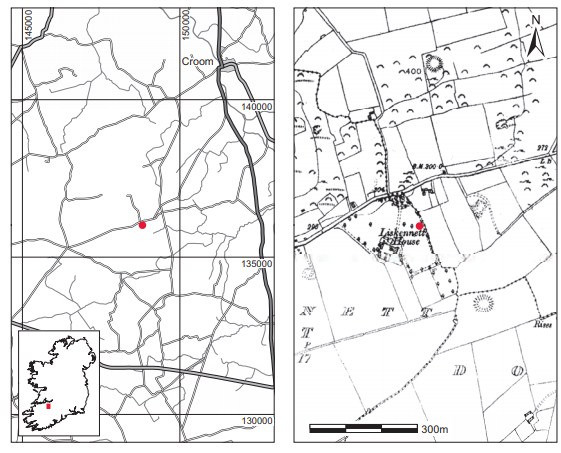County: Limerick Site name: MORENANE, CO. LIMERICK
Sites and Monuments Record No.: SMR LI030-104 Licence number: —
Author: DAVID CANTWELL
Site type: Early Bronze Age graves
Period/Dating: —
ITM: E 548781m, N 636068m
Latitude, Longitude (decimal degrees): 52.473640, -8.753899
Introduction
While extending a sandpit near Croom, Co. Limerick, in March 1950, workmen discovered a short cist containing an inhumation. The capstone of the cist, which lay approximately 0.3m below ground level, was lifted and the bones within were shovelled out of the grave by the workmen. Fortunately, the walls of the cist remained intact for a few days after discovery. The site was visited by the local National School teacher, Mr David Cantwell, who reported the discovery to the NMI via the Irish Folklore Commission. In the meantime, the site was visited by Mr John Hunt of Lough Gur, Co. Limerick, who reported that by this time the cist stones had been moved. The bones in the cist were taken into custody by the Gardaí but later came to the NMI. After John Hunt’s report that the cist was virtually destroyed, it was decided that a Museum visit to the site was not merited. This report is therefore based on Mr Cantwell’s account and illustration of the cist, prior to its destruction. The human remains from the site were analysed by Professor E.J. Keenan.
Location (Fig. 3.104)
The cist was in the townland of Morenane, mid-Co. Limerick, approximately 5km south-west of Croom village.171 It lay at the southern base of Morenane hill, between 40m and 50m above sea level. No related sites are known from the locality, but Mr Cantwell did notice a circular pile of smaller stones, approximately 0.2m below ground level and within a ‘few feet’ of the cist, which may have been an associated burial.172


Description of site
The cist was polygonal in plan, with its long axis aligned north/south. According to Mr Cantwell, the cist was coffin-shaped in outline. The capstone and five of the sidestones were of limestone and the two other uprights possibly of sandstone. It measured 1.14m long by 0.84m wide by 0.69m deep (Fig. 3.105).173 It was formed of seven side slabs set on edge, one forming the northern wall, two each the eastern and western sides, and two the southern end. The two slabs forming the southern end of the chamber converged at an angle of about 130º, giving the cist its polygonal shape. The crevices between the northern end stone and the side stones at either edge of it were filled with smaller packing stones. The cist was covered with a capstone of irregular shape.174 The floor of the cist was paved with three regular slabs, placed close to each other in an east/west direction and fitting tightly together. There were no other packing stones around the cist and there is no evidence that the pit dug to receive the cist was discovered.
The cist contained an inhumation of a young adult male (2010:81) and no accompanying artefacts were found. If the body was articulated it would probably have been in a crouched position, given the length of the cist, but unfortunately it is not possible to say, as the remains were removed from the cist before it was examined by Mr Cantwell
Comment
The human remains from this site have not been dated. The site is assumed to be early Bronze Age in date, based on its form. Ryan (1981, 145) rejects Raftery’s (1974, 304n) assertion that this site can be classified as a Linkardstown cist. Waddell (1990, 111) also lists it as an early Bronze Age burial.
HUMAN REMAINS
E.J. KEENAN
The bones are those of a young adult male (18–25 years), height 5ft 5in. [1.65m], of good muscular development. There is no evidence of disease in the bones. The teeth are in perfect condition and show little signs of wear. All teeth (permanent) were present at death. The condition of the skull did not permit of accurate measurements, and therefore indices could not be calculated. From visual examination of the fragments the skull seems broad and low, but of good capacity.
171. Parish of Ballingarry, barony of Connello Upper. SMR LI030-104——. IGR 148820 136020.
172. This was not investigated.
173. It is not clear whether these measurements are external or internal, as it is not stated in the report and as the plan is not to scale.
174. Its dimensions are not provided.